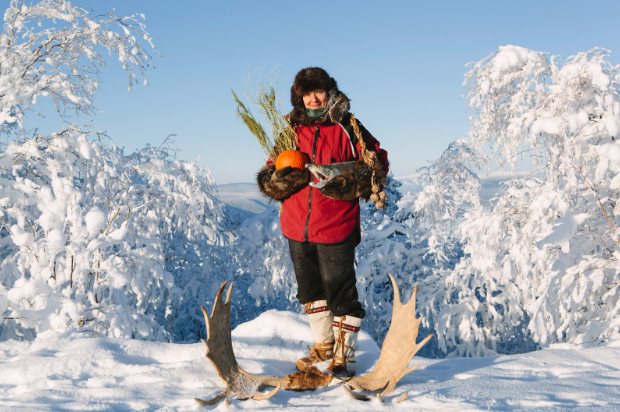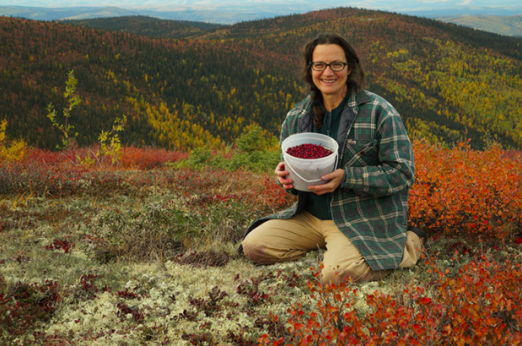This Is What Hyperlocal Food Looks Like in the Yukon
Think it would be tough to eat exclusively local food for a year? This Dawson City family showed that it can be done — even in a subarctic climate.
This Is What Hyperlocal Food Looks Like in the Yukon
Think it would be tough to eat exclusively local food for a year? This Dawson City family showed that it can be done — even in a subarctic climate.

Suzanne Crocker, with the bounty of the North.Suzanne Crocker
Dawson City, Yukon, a town of about 1,400 known primarily for its role in the Klondike Gold Rush, doesn’t get much media attention. But this summer, when news broke that resident Suzanne Crocker and her family had completed a year of eating nothing but foods grown, hunted or foraged in the area, the camera crews descended.
Crocker herself is making a documentary about the experience, including the biggest challenge of all: persuading her husband and three children to join her.
Of course Indigenous people have been eating 100 percent local in frozen northern places for thousands of years, and thriving. Yet today, Dawson City, where the growing season lasts but 66 days, imports 97 percent of its food — an unhealthy reality for people across northern Canada and Alaska. Bringing attention to this sad fact was the greater purpose of Crocker’s mad dare.

It’s an incredibly important conversation, as the rates of diabetes and other diet-related diseases are astronomical in northern communities. And the high cost of imported food helps to perpetuate a cycle of poverty.
But also important — and exciting — are the foods native to northern climes, which get little lip service in the rest of the world. Here’s a sampling of some of the exotic tastes that the Crocker family came to discover.
Moose
The meat is extremely dense and lean. It’s known for having a gamey flavor, though moose hunted in summer, when the animals are able to graze on fresh grass, can be quite mild. Moose lips are considered a delicacy in northern Russia.
Haskap
These are the berries of a shrub in the honeysuckle family. They taste like a combination of blueberries and raspberries, but with astringent undertones. Capable of withstanding temperatures to -50 degrees Fahrenheit, haskaps are cultivated as commercial crop (albeit on a limited scale) in some northerly locales.
Spruce Tips
The growing tips of spruce branches have a delicious citrusy flavor when they emerge in spring. They are used in herbal teas, as a spice and as a raisin substitute in cookies and other baked goods. Not typically eaten raw, spruce tips may be consumed as a pickled vegetable.
Bear Root
Also known as Eskimo potato, this species is related to sweet peas, but it is the roots that are edible. Some accounts say the tubers, which taste like carrots, were traditionally eaten raw with seal oil, though they may also be boiled or roasted. A closely related, but poisonous species is believed to be what killed Chris McCandless, the subject of the film Into the Wild, in Alaska.
Birch Syrup
Maple trees only grow so far north. But with a native range extending well into the arctic, birch trees are among the most cold-hardy hardwoods. And they produce a copious sap that can be tapped and boiled down into a syrup known for its complex array of woodsy, fruity and caramel flavors.
Follow us
This work is licensed under a Creative Commons Attribution-NoDerivatives 4.0 International License.
Want to republish a Modern Farmer story?
We are happy for Modern Farmer stories to be shared, and encourage you to republish our articles for your audience. When doing so, we ask that you follow these guidelines:
Please credit us and our writers
For the author byline, please use “Author Name, Modern Farmer.” At the top of our stories, if on the web, please include this text and link: “This story was originally published by Modern Farmer.”
Please make sure to include a link back to either our home page or the article URL.
At the bottom of the story, please include the following text:
“Modern Farmer is a nonprofit initiative dedicated to raising awareness and catalyzing action at the intersection of food, agriculture, and society. Read more at <link>Modern Farmer</link>.”
Use our widget
We’d like to be able to track our stories, so we ask that if you republish our content, you do so using our widget (located on the left hand side of the article). The HTML code has a built-in tracker that tells us the data and domain where the story was published, as well as view counts.
Check the image requirements
It’s your responsibility to confirm you're licensed to republish images in our articles. Some images, such as those from commercial providers, don't allow their images to be republished without permission or payment. Copyright terms are generally listed in the image caption and attribution. You are welcome to omit our images or substitute with your own. Charts and interactive graphics follow the same rules.
Don’t change too much. Or, ask us first.
Articles must be republished in their entirety. It’s okay to change references to time (“today” to “yesterday”) or location (“Iowa City, IA” to “here”). But please keep everything else the same.
If you feel strongly that a more material edit needs to be made, get in touch with us at [email protected]. We’re happy to discuss it with the original author, but we must have prior approval for changes before publication.
Special cases
Extracts. You may run the first few lines or paragraphs of the article and then say: “Read the full article at Modern Farmer” with a link back to the original article.
Quotes. You may quote authors provided you include a link back to the article URL.
Translations. These require writer approval. To inquire about translation of a Modern Farmer article, contact us at [email protected]
Signed consent / copyright release forms. These are not required, provided you are following these guidelines.
Print. Articles can be republished in print under these same rules, with the exception that you do not need to include the links.
Tag us
When sharing the story on social media, please tag us using the following: - Twitter (@ModFarm) - Facebook (@ModernFarmerMedia) - Instagram (@modfarm)
Use our content respectfully
Modern Farmer is a nonprofit and as such we share our content for free and in good faith in order to reach new audiences. Respectfully,
No selling ads against our stories. It’s okay to put our stories on pages with ads.
Don’t republish our material wholesale, or automatically; you need to select stories to be republished individually.
You have no rights to sell, license, syndicate, or otherwise represent yourself as the authorized owner of our material to any third parties. This means that you cannot actively publish or submit our work for syndication to third party platforms or apps like Apple News or Google News. We understand that publishers cannot fully control when certain third parties automatically summarize or crawl content from publishers’ own sites.
Keep in touch
We want to hear from you if you love Modern Farmer content, have a collaboration idea, or anything else to share. As a nonprofit outlet, we work in service of our community and are always open to comments, feedback, and ideas. Contact us at [email protected].by Brian Barth, Modern Farmer
November 21, 2018
Modern Farmer Weekly
Solutions Hub
Innovations, ideas and inspiration. Actionable solutions for a resilient food system.
ExploreExplore other topics
Share With Us
We want to hear from Modern Farmer readers who have thoughtful commentary, actionable solutions, or helpful ideas to share.
SubmitNecessary cookies are absolutely essential for the website to function properly. This category only includes cookies that ensures basic functionalities and security features of the website. These cookies do not store any personal information.
Any cookies that may not be particularly necessary for the website to function and are used specifically to collect user personal data via analytics, ads, other embedded contents are termed as non-necessary cookies.
As a 64 yo Alaskan, before she was a State, I have hunted, gathered, fished, and fermented in all sections of my Alaska, including above the Arctic Circle. There is more bounty than this article could ever fit in. With some knowledge and faith in local wisdom, you would never starve in Alaska. I love these stories! Thank you, Modern Farmer.
Perhaps this will come out in the documentary, but I am interested in hearing more! How about a food analysis of nutrients and calories in different seasons and which foods they came from? You mention a lot of seasonal foods here, and I’m sure the winters were long.
I see that they are eating moose meat, berries ‘Eskimo potatoes’*, spruce tips (the growing tip, killing further growth), and birch syrup. Although the diet is bizarre, it may be sufficient to sustain life over time. Christopher McCandless was not so lucky. * Ronald Hamilton, a retired bookbinder at the Indiana University of Pennsylvania, suggested a link between the symptoms described by McCandless and the poisoning of Jewish prisoners in the Nazi concentration camp in Vapniarca. He put forward the proposal that McCandless starved to death because he was suffering from paralysis in his legs induced by lathyrism, which prevented… Read more »
Fascinating! Would love to learn more about their storage and methods of preserving. Also what other foraged foods, especially fruits, might be available. For example juniper and Saskatoon berries.